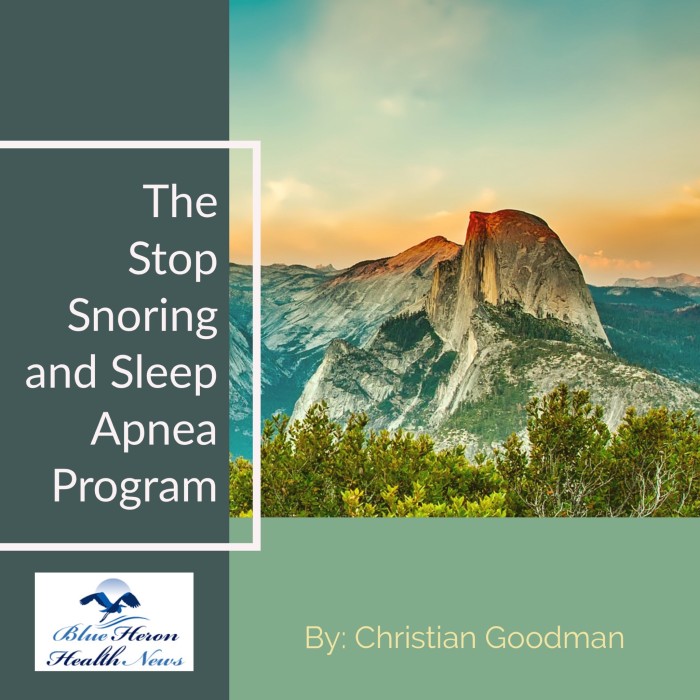This eBook from Blue Heron Health NewsBack in the spring of 2008, Christian Goodman put together a group of like-minded people – natural researchers who want to help humanity gain optimum health with the help of cures that nature has provided. He gathered people who already know much about natural medicine and setup blueheronhealthnews.com. Today, Blue Heron Health News provides a variety of remedies for different kinds of illnesses. All of their remedies are natural and safe, so they can be used by anyone regardless of their health condition. Countless articles and eBooks are available on their website from Christian himself and other natural health enthusiasts, such as Julissa Clay , Shelly Manning , Jodi Knapp and Scott Davis. The Stop Snoring And Sleep Apnea Program™ By Christian Goodman The Stop Snoring and Sleep Apnea Program is a well-researched program created to help stop snoring and sleep apnea so that you can have a good night sleep. The techniques that you will learn from this program works immediately. It will only take you 3-7 minutes to perform these simple exercises that the author has recommended but the results that you will get will help you have a good night sleep as soon as tonight. Within a week, snoring will be a thing of the past.
|
The First CPAP Machines
The original CPAP machines were developed in the 1980s, revolutionizing the treatment of sleep apnea. Here is a story about how they were developed:
1. Early 1980s – The Idea Emerges
The concept of CPAP therapy developed due to necessity in order to cure obstructive sleep apnea (OSA), in which an individual’s airway during sleep intermittently closes and creates interruptions in breathing. Prior, there weren’t many viable or restrictive treatments available for it, and whatever ones did were focusing on surgery or oxygenation.
The turning point was in 1981, when sleep researcher Dr. Christian Guilleminault published research that confirmed the link between sleep apnea and severe health risks such as high blood pressure and cardiovascular disease. Meanwhile, Australian physician Dr. Colin Sullivan began experimenting with non-invasive ways of keeping an airway open.
2. The First CPAP Machine (1981)
Dr. Colin Sullivan and colleagues at Sydney’s Royal Prince Alfred Hospital developed the first functional CPAP machine. Their first prototype was very crude. It used a fan to blow the air, a hose to pass the air through a nasal mask, and a strap to secure the mask over the face. Air pressure kept the airways open during sleep.
Sullivan’s device was based on the principle of maintaining a steady flow of air down the airway in order to prevent it from collapsing, an approach that would become the standard treatment for sleep apnea.
3. 1980s – Early Adoption and Development
In the early days, CPAP therapy was quite uncomfortable and uncomfortable for patients. The early CPAP devices were large, cumbersome, and loud. They were used mostly in hospitals on acute obstructive sleep apnea patients. As more research evolved, doctors began to prescribe CPAP for at-home use to patients diagnosed with sleep apnea.
4. 1990s – Refinement and Wider Acceptance
By the 1990s, CPAP technology had come a long way. The machines became quieter, more compact, and more user-friendly. An important milestone was when companies like ResMed and Philips Respironics came into the market and began producing portable CPAP machines to be used at home.
The introduction of softer masks, less noisy devices, and pressure levels to be controlled made CPAP more practical as a long-term therapy. As more individuals were informed about sleep apnea and knew the dangerous health risks of untreated sleep apnea (including heart disease, stroke, and daytime fatigue), CPAP treatment gained broader recognition and application.
5. Modern CPAP Devices (2000s-Present)
CPAP devices now are far more advanced. The newer devices are quieter, smaller, and even have automatic pressure adjustment based on breathing patterns, humidifiers to reduce discomfort, and even connectivity options that allow remote monitoring by doctors. There are also greater options of masks to choose from, including full-face masks, nasal pillows, and nasal masks, which make it easier for patients to be able to get a comfortable fit.
Impact on Sleep Apnea Treatment
The creation of the first CPAP device was a landmark in sleep apnea treatment. It shifted the trend from invasive surgery and life adjustment to an effective, non-surgical treatment that significantly improved the quality of life of millions of people suffering from sleep apnea. It has remained the gold standard of sleep apnea treatment for over four decades.
Overall, the early CPAP machines paved the way for modern, effective treatment of obstructive sleep apnea, bringing relief to millions of patients and significantly reducing the linked health hazards.
Over time, people have sought a variety of treatments for snoring, ranging from slight lifestyle modifications to more complicated interventions. Some of the more notable historical remedies for snoring include:
1. Sleeping Positions
Side Sleeping: One of the earliest and simplest snoring treatments was adjustment of sleep position. People were instructed to sleep on their sides rather than on their backs since sleeping on the back causes the tongue and soft tissues to roll backward, which leads to the blockage of the airway and the production of snoring sounds.
Propping Up the Head: Another of the older practices was elevation of the head on pillows or wooden supports in order to open the airway and prevent it from becoming blocked. It was believed to reduce snoring through an opened airway.
2. Herbal and Natural Remedies
Herbal Teas: Chamomile, peppermint, and ginger were among herbs used in teas to soothe the throat and reduce snoring. They assumed that these herbs had anti-inflammatory properties that would reduce airway swelling.
Garlic: Garlic has been utilized for centuries due to its medicinal benefits. It was believed that consumption of garlic, being antibacterial and anti-inflammatory in nature, would reduce throat congestion and snoring.
Honey and Lemon: Mixing lemon with honey in hot water was commonly used as a natural remedy to reduce throat irritation and calmness, hopefully alleviating snoring.
3. Surgical and Physical Procedures
Tonsillectomies and Adenoidectomy: In times past, when snoring was caused by enlarged adenoids or tonsils, surgical excision of the tissues was sometimes performed. This was especially common in kids.
Throat Tightening: Physical methods like massaging the throat gently or pushing on specific regions to tighten up muscles and reduce snoring were employed by certain cultures.
4. Avoidance of Alcohol
Avoiding Alcohol Prior to Bedtime: It was understood that alcohol would relax the muscles of the throat, increasing the likelihood of snoring. As a result, most cultures advised people to avoid alcohol, especially prior to bedtime, as a preventive strategy against snoring.
5. Aromatherapy and Scents
Essential Oils: Traditional remedies typically involved using essential oils such as eucalyptus or lavender. It was thought that these oils could clear the airways and make people relax, thus facilitating easier breathing and less snoring.
Incense: In certain societies, the use of burning particular kinds of incense, like myrrh or frankincense, was believed to open up nasal passages and decrease the occurrence of snoring.
6. Wearing Noises or Snoring “Deterrents”
Nose Plugs or Wires: Some historical remedies involved wearing devices like nose plugs or even metal wires to help keep the breathing passages open. These would have been painful but were believed to be helpful by preventing the nasal passage from collapsing during sleep.
Mouth Guards: Simple mouth guards were sometimes used to place the jaw in a way that it would not collapse the airway. Though less sophisticated than modern mandibular advancement devices, these early ones were meant to mitigate snoring.
7. Folk Beliefs and Rituals
Superstitions: There were a few cultures in which snoring was believed to be a sign of evil spirits or ill luck. Chanting, prayers of a special kind, or even charms were employed at times to repel the cause of snoring, which was a belief to be supernatural.
Amulets and Talismans: In certain regions, people felt that the use of an amulet or a talisman would prevent snoring by protecting the sleeper from evil energies or spirits that were thought to cause the condition.
8. Fasting or Dietary Restrictions
Dietary Modifications: Dietary restrictions were presumed in some ancient societies to discourage snoring. For example, it was thought that it was possible to avoid snoring by eating less at night or refraining from heavy dinner intake prior to bed.
Fasting: Fasting or purging was presumed in some spiritual or religious activities to enhance overall health and also to get rid of symptoms like snoring, which were usually associated with excess or imbalance.
These treatments were at times based on the prevailing medical knowledge of the time and were handed down from generation to generation. Although some of them may have been beneficial in the short term, most of the ancient practices were more a matter of trial and error or common sense than based on scientific evidence. Today, although some of them continue to be practiced, treatment has evolved significantly with improvements in medical knowledge.

The Stop Snoring And Sleep Apnea Program™ By Christian Goodman The Stop Snoring and Sleep Apnea Program is a well-researched program created to help stop snoring and sleep apnea so that you can have a good night sleep. The techniques that you will learn from this program works immediately. It will only take you 3-7 minutes to perform these simple exercises that the author has recommended but the results that you will get will help you have a good night sleep as soon as tonight. Within a week, snoring will be a thing of the past.
This eBook from Blue Heron Health NewsBack in the spring of 2008, Christian Goodman put together a group of like-minded people – natural researchers who want to help humanity gain optimum health with the help of cures that nature has provided. He gathered people who already know much about natural medicine and setup blueheronhealthnews.com. Today, Blue Heron Health News provides a variety of remedies for different kinds of illnesses. All of their remedies are natural and safe, so they can be used by anyone regardless of their health condition. Countless articles and eBooks are available on their website from Christian himself and other natural health enthusiasts, such as Julissa Clay , Shelly Manning , Jodi Knapp and Scott Davis. |
